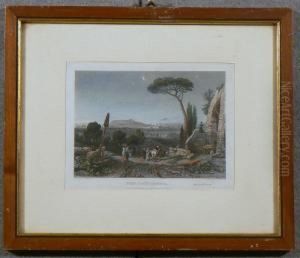James Tilbitts Willmore Paintings
James Tibbetts Willmore was a distinguished English engraver born in 1800, recognized for his mastery in the art of engraving, particularly within the landscape genre. His life and career were marked by a dedication to capturing the sublime beauty of nature and the meticulous translation of paintings into engravings that were both technically accomplished and deeply evocative. Willmore was born in Birmingham, a city that was, during the 19th century, a vibrant hub for the arts and industry in England. This environment likely provided him with the initial inspiration and resources to pursue a career in the arts.
Willmore's skill in engraving was developed under the tutelage of Edward Goodall, another prominent figure in the field of engraving. This apprenticeship was crucial in shaping Willmore's technical abilities and artistic sensibilities. Throughout his career, Willmore became particularly associated with the works of J. M. W. Turner, one of the most esteemed English painters of the period. Willmore's engravings of Turner's paintings are among his most celebrated works, showcasing his ability to capture the luminosity and atmospheric effects that Turner's paintings are renowned for.
Throughout the mid-19th century, Willmore's reputation grew, and he became a central figure in the world of English art engraving. His works were widely collected and admired not only in England but also internationally, contributing to the spread of the appreciation of landscape art in the Victorian era. Willmore's engravings often featured dramatic landscapes, seascapes, and historical scenes, executed with a precision and sensitivity that made them stand out among the works of his contemporaries.
James Tibbetts Willmore's contributions to the field of engraving were recognized by his peers and by the Royal Academy, where he exhibited his works on several occasions. Despite the eventual decline in the popularity of engraving as a primary form of art reproduction, due to the rise of photographic processes, Willmore's work remains a testament to the skill and artistic vision of engravers in the 19th century.
Willmore passed away in 1863, leaving behind a legacy of artistic excellence that continues to be appreciated by art historians and collectors alike. His engravings serve as a window into the 19th-century landscape genre, reflecting both the technical achievements of the period and the enduring beauty of the natural world as seen through the eyes of some of its finest artists.
